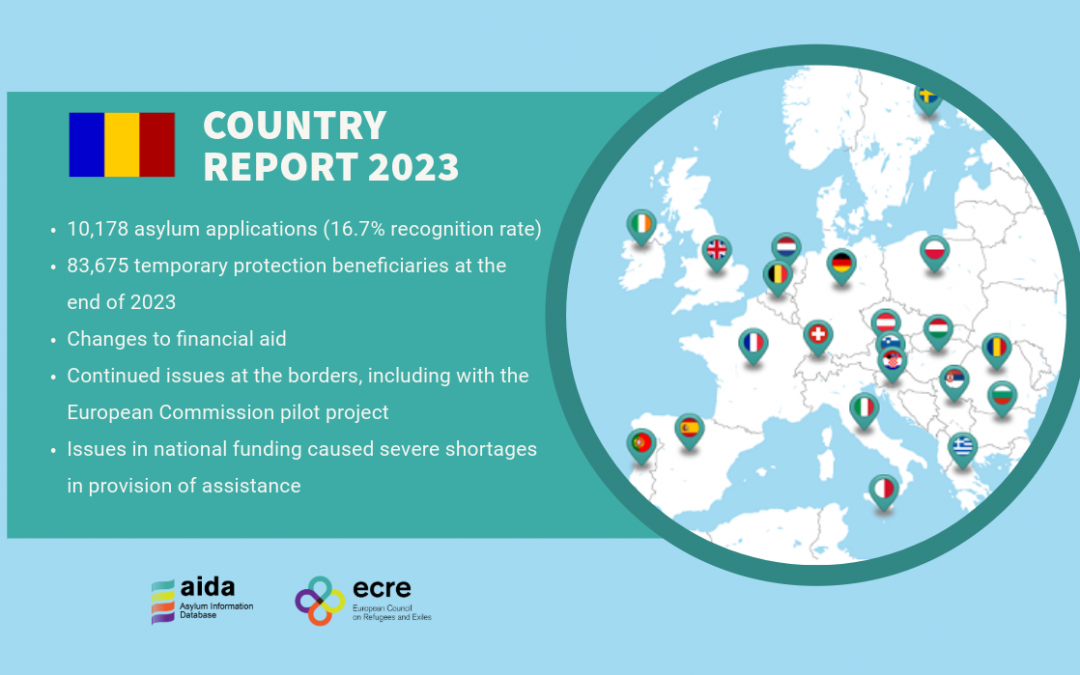The updated AIDA Country Report on Romania provides a detailed overview of legislative and practice-related developments in asylum procedures, reception conditions, detention of asylum seekers and content of international protection in 2023. It also includes an annex which provides an overview of temporary protection (TP).
In 2023, 10,178 applications for international protection were made in Romania. The most represented countries of origin were Bangladesh, Syria and Pakistan. At the same time, 1,016 people (mostly from Syria and Somalia) were granted international protection. The recognition rate was 16.7% (down from 25.7% in 2022) and there were wide discrepancies between nationalities: 0% recognition rate for Bangladeshis, 2.5% for Pakistanis and 62.5% for Syrians.
Access to the territory and the asylum procedure remained a challenge in 2023 with continued reports of pushbacks, ill-treatment, including physical violence, at the border and the use of readmission agreements, although the latter was to a lesser degree compared to 2022. In March 2023, Romania started the implementation of a six-month EU-funded pilot project focused on border management with Serbia and accelerated procedures. A Romanian official stated that the project enabled Romanian authorities to identify groups of migrants who approached the Serbia-Romania border and thus to notify Serbian authorities “long before they reach the border”. The European Commission considered the pilot to be a success. The asylum law was amended in the context of the pilot project. As a result, the right of asylum seekers’ to remain in Romania was limited until the end of the asylum procedure, officials from the EU Agency for Asylum were allowed to register, interview and analyse asylum applications, and the issuance of return decisions together with the negative decision on international protection was foreseen.
The reception of asylum applicants and the inclusion of new beneficiaries of international protection (BIPs) was severely hindered by the end of the Asylum, Migration and Integration Fund national programme in October 2023 as it forced a number of non-governmental organisations (NGOs) that had been providing legal, medical and financial assistance to suspend their projects. (NB/ Funding was eventually resumed in June 2024).
In August 2023, a joint ministerial order further specified the appointment, role, tasks, training and professional experience of legal representatives for unaccompanied minors (UAMs). As a result, some UAMs have faced particular difficulties in exercising their right to family reunification as the legal representative is responsible for initiating the necessary steps to identify the child’s family and assessing whether or not reunification is possible.
Regarding BIPs, many barriers to meaningful inclusion remained in 2023. People who were able to find employment were generally paid minimum wage and were unable to afford a decent living. This was especially the case for families with children. The most commonly reported barriers to employment continued to be insufficient knowledge of Romanian and non-recognition of prior qualifications. In addition, lack of proper knowledge, language barriers, arbitrary refusals of care by doctors, general issues in the Romanian healthcare system, including long delays for specialists, and the cost of medical services severely hindered BIPs’ effective access to healthcare.
In 2023, 51,984 Ukrainians received TP status in Romania. According to the United Nations Refugee Agency (UNHCR), in December 2023 there were 83,675 refugees from Ukraine in Romania. As of 1 May 2023, a number of elements of the support programme that granted financial assistance to TP beneficiaries for housing and food/subsistence were amended. The legal framework was also amended shortly afterwards. As result, TP beneficiaries were required to register with the employment agency to continue receiving financial assistance.
The full report is available here and the annex on temporary protection is available here.
For more information about the AIDA database or to read other AIDA reports, please visit the AIDA website.

